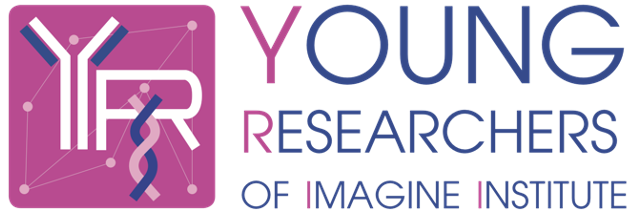Program
Reception desk / Imagine entrance
Oral presentations / auditorium
Poster presentations / 7th floor
Coffee and lunch breaks / 6th floor
-
-
9:00 AM Corentin Le Floc'h
Autosomal dominant ZAP70 deficiency9:15 AM Juan Eduardo Montero-Hernández
CCL2 chemokine follows a complex bi-temporal secretion pattern for local attraction during IgE-mediated mast cell activation9:30 AM Marco M Rodari
Human integrin alpha-V deficiency skews B cell responses toward extra-follicular pathways in IgE-mediated allergy9:45 AM Aldevron
10:00 AM Lea Nabhan
A genome-wide CRISPR interference (CRISPRi) screen to identify essential V(D)J/DNA repair genes10:15 AM Boris Bessot
Gene therapy for Artemis-SCID patients: preliminary results of the French ARTEGENE phase I/II clinical trial
Coffee break / 30 minutes
-
11:00 AM Christin Weissleder
Parkinson’s Disease and the Gut-Brain Axis: How Microbial Metabolites and Genetic Risk Drive Immune Cell Dysfunction11:15 AM Zoéline Mars
DDX41, a gene associated with predisposition to hematological malignancies, is responsible for syndromic retinal dystrophy11:30 AM Joran Martin
Primary cilium drives inflammatory response associated with uropathogenic bacteria infection and kidney obstruction damage11:45 AM ProteinTech
-
12:00 AM Bianca Ionela Slivinschi
A novel iPSC-derived Gut-on-Chip model for studying Parkinson’s Disease pathology12:15 AM Joël Boivin
Generation of new zebrafish models via precise genome editing
Lunch break / 12:30 PM - 01:30 PM
-
01:30 PM Lucile Marchal
Multi-omic analysis of cutaneous squamous cell carcinoma in patients with Recessive Dystrophic Epidermolysis Bullosa identifies new therapeutic targets01:45 PM Romain Nicolle
Graph neural networks reveal digenic disease candidates through biological network analysis02:00 PM Adrien Schvartz
Specific Transcriptomic Signature in Oligoarticular JIA Patients Who Will Not Respond to Anti-TNFα Treatment
-
-
01 Khawla Aljabali
Multimodal Brain Imaging in Autism Spectrum Disorders in Patients with SHANK3 mutations02 Huyen Augis Chu
Sample clearing and 3D imaging03 Antoine Gonde
Germline variants in JAK3 and chronic active EBV infection associated with auto-inflammation and skin disease04 Elena Retana
Development of prime editing strategies for alpha-thalassemia05 Mathilde Nesson-Dauphin
Cellular and zebrafish approaches to model a neurodevelopmental disorder caused by CACNA1G mutations06 Marine Gloanec
Kinetics of ventricular growth defects in the heterotaxy syndrome07 Judith Beaux
Reln sources in cortical development and neurodevelopmental disorders08 Candice Moncler
Missense variants in the second transmembrane domain of TMEM17 disrupt its stability and function and lead to a wide phenotypic spectrum of ciliopathies09 Gwenaëlle Laurent
Unraveling the pathophysiology of TANGO2 disease10 Mohamed Kehili
The role of mitochondrial unfolded protein response activation over neuronal functions and glial reactivity11 Malena Pérez Lorenzo
A novel form of inherited human RelB deficiency12 Alice Lecomte
Atlas of human cardiac development during the embryonic period13 Lucie Day
Role of ADAR1 and RNA editing in peripheral myelin maintenance14 Janja Kovacic
Enhanced TLR7 and TLR9 Signaling in Plasmacytoid Dendritic Cells Expressing UNC93B1 Mutations15 Maeva Hubert
Extracellular matrix asymmetries during heart looping16 Carmela Giachino
Dissecting the role of LRRK2 in intercellular communication using iPSC-derived neuron-glia tricultures17 Hariam Raji
A multi-organoid microfluidic approach to investigate the gut-brain axis in Parkinson’s disease
Coffee break / 15 minutes
-
Florence Gazeau
Nanomedicine approaches for immuno and biotherapies
Physicist by training, Florence Gazeau is Research Director (DR) at CNRS. In 2024, she was awarded the CNRS silver medal for her fundamental and applied research on magnetic nanoparticles for imaging and precision therapy. Very recently, she became member of the French Academy of Sciences. Florence Gazeau is now head of the NABI laboratory (INSERM, CNRS, Université Paris-cité), at the forefront of research into nanomedicine and extracellular vesicles.
-
Conclusion by Bana Jabri and prizes presented by Nadine Cerf-Bensussan
-
7th floor
